airbag off MITSUBISHI ASX 2018 Owner's Manual (in English)
[x] Cancel search | Manufacturer: MITSUBISHI, Model Year: 2018, Model line: ASX, Model: MITSUBISHI ASX 2018Pages: 514, PDF Size: 34.89 MB
Page 4 of 514
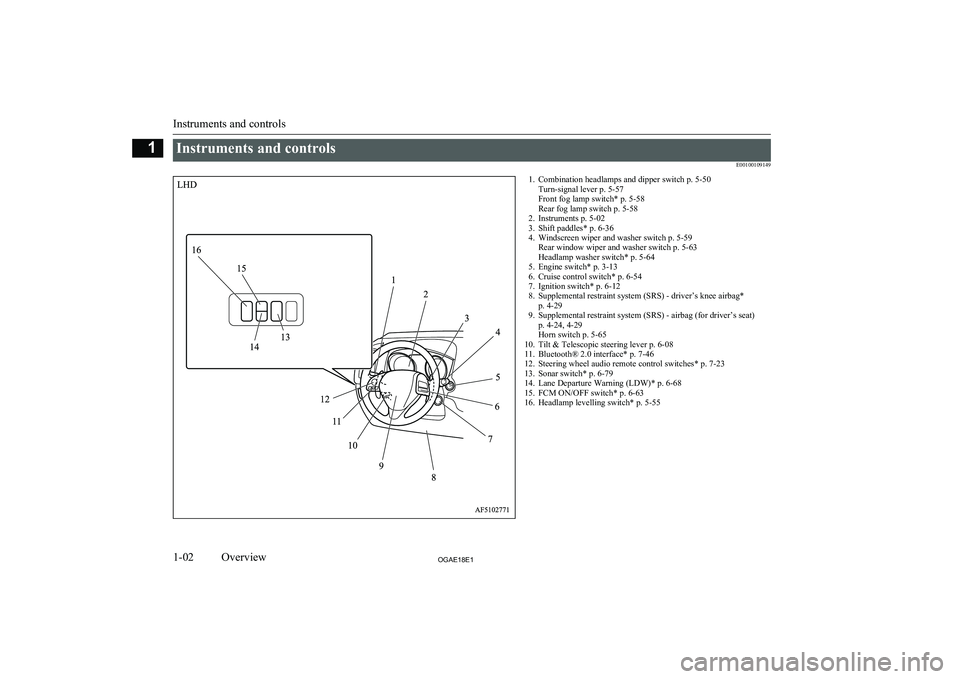
Instruments and controlsE001001091491. Combination headlamps and dipper switch p. 5-50Turn-signal lever p. 5-57
Front fog lamp switch* p. 5-58
Rear fog lamp switch p. 5-58
2. Instruments p. 5-02
3. Shift paddles* p. 6-36
4. Windscreen wiper and washer switch p. 5-59 Rear window wiper and washer switch p. 5-63
Headlamp washer switch* p. 5-64
5. Engine switch* p. 3-13
6. Cruise control switch* p. 6-54
7. Ignition switch* p. 6-12
8. Supplemental restraint system (SRS) - driver’s knee airbag* p. 4-29
9. Supplemental restraint system (SRS) - airbag (for driver’s seat) p. 4-24, 4-29
Horn switch p. 5-65
10. Tilt & Telescopic steering lever p. 6-08
11. Bluetooth® 2.0 interface* p. 7-46
12. Steering wheel audio remote control switches* p. 7-23
13. Sonar switch* p. 6-79
14. Lane Departure Warning (LDW)* p. 6-68
15. FCM ON/OFF switch* p. 6-63
16. Headlamp levelling switch* p. 5-55
Instruments and controls
1-02OGAE18E1Overview1
Page 5 of 514
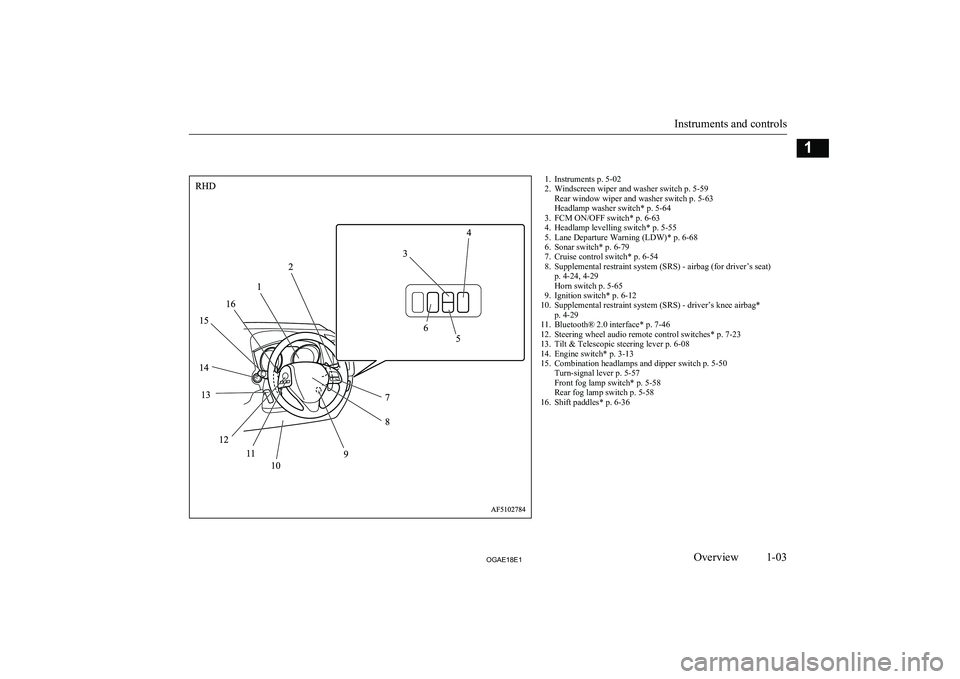
1. Instruments p. 5-02
2. Windscreen wiper and washer switch p. 5-59 Rear window wiper and washer switch p. 5-63
Headlamp washer switch* p. 5-64
3. FCM ON/OFF switch* p. 6-63
4. Headlamp levelling switch* p. 5-55
5. Lane Departure Warning (LDW)* p. 6-68
6. Sonar switch* p. 6-79
7. Cruise control switch* p. 6-54
8. Supplemental restraint system (SRS) - airbag (for driver’s seat) p. 4-24, 4-29
Horn switch p. 5-65
9. Ignition switch* p. 6-12
10. Supplemental restraint system (SRS) - driver’s knee airbag* p. 4-29
11. Bluetooth® 2.0 interface* p. 7-46
12. Steering wheel audio remote control switches* p. 7-23
13. Tilt & Telescopic steering lever p. 6-08
14. Engine switch* p. 3-13
15. Combination headlamps and dipper switch p. 5-50 Turn-signal lever p. 5-57
Front fog lamp switch* p. 5-58
Rear fog lamp switch p. 5-58
16. Shift paddles* p. 6-36
Instruments and controls
1-03OGAE18E1Overview1
Page 6 of 514
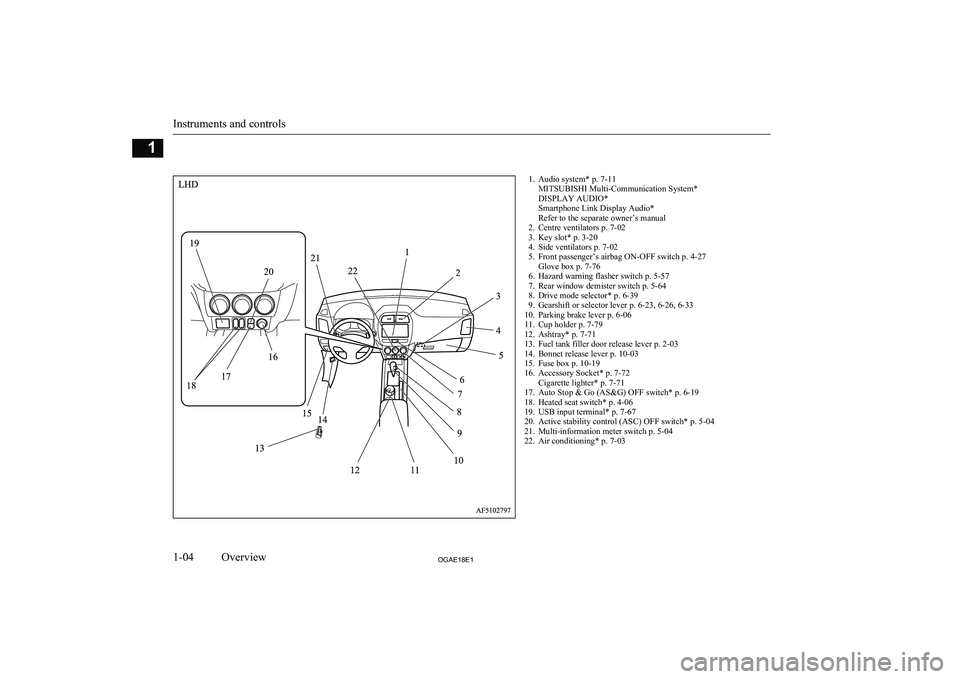
1. Audio system* p. 7-11MITSUBISHI Multi-Communication System*
DISPLAY AUDIO*
Smartphone Link Display Audio*
Refer to the separate owner’s manual
2. Centre ventilators p. 7-02
3. Key slot* p. 3-20
4. Side ventilators p. 7-02
5. Front passenger’s airbag ON-OFF switch p. 4-27 Glove box p. 7-76
6. Hazard warning flasher switch p. 5-57
7. Rear window demister switch p. 5-64
8. Drive mode selector* p. 6-39
9. Gearshift or selector lever p. 6-23, 6-26, 6-33
10. Parking brake lever p. 6-06
11. Cup holder p. 7-79
12. Ashtray* p. 7-71
13. Fuel tank filler door release lever p. 2-03
14. Bonnet release lever p. 10-03
15. Fuse box p. 10-19
16. Accessory Socket* p. 7-72 Cigarette lighter* p. 7-71
17. Auto Stop & Go (AS&G) OFF switch* p. 6-19
18. Heated seat switch* p. 4-06
19. USB input terminal* p. 7-67
20. Active stability control (ASC) OFF switch* p. 5-04
21. Multi-information meter switch p. 5-04
22. Air conditioning* p. 7-03
Instruments and controls
1-04OGAE18E1Overview1
Page 7 of 514
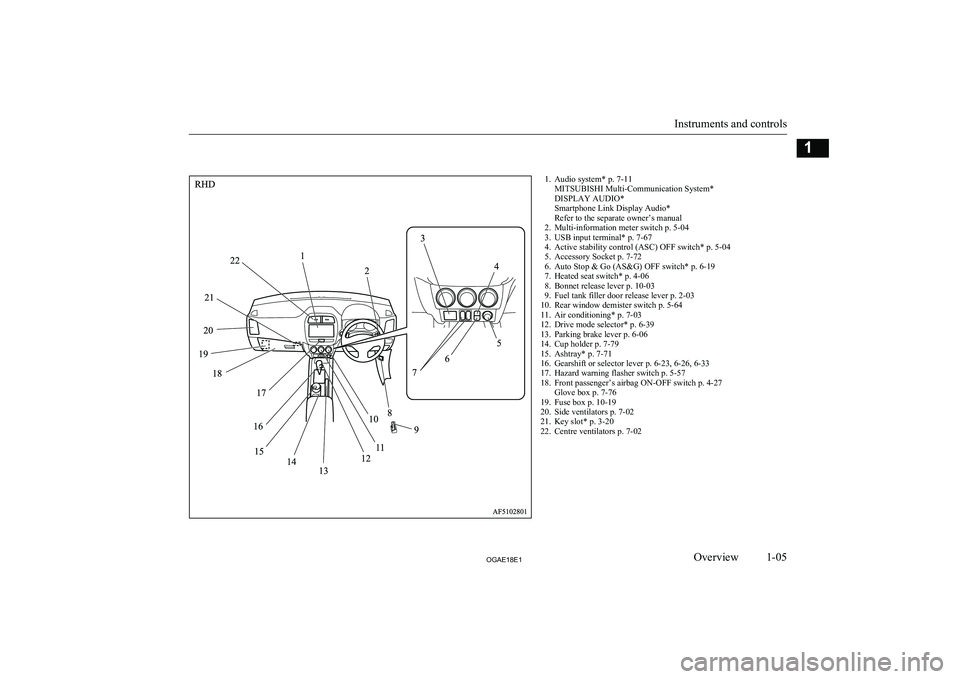
1. Audio system* p. 7-11MITSUBISHI Multi-Communication System*
DISPLAY AUDIO*
Smartphone Link Display Audio*
Refer to the separate owner’s manual
2. Multi-information meter switch p. 5-04
3. USB input terminal* p. 7-67
4. Active stability control (ASC) OFF switch* p. 5-04
5. Accessory Socket p. 7-72
6. Auto Stop & Go (AS&G) OFF switch* p. 6-19
7. Heated seat switch* p. 4-06
8. Bonnet release lever p. 10-03
9. Fuel tank filler door release lever p. 2-03
10. Rear window demister switch p. 5-64
11. Air conditioning* p. 7-03
12. Drive mode selector* p. 6-39
13. Parking brake lever p. 6-06
14. Cup holder p. 7-79
15. Ashtray* p. 7-71
16. Gearshift or selector lever p. 6-23, 6-26, 6-33
17. Hazard warning flasher switch p. 5-57
18. Front passenger’s airbag ON-OFF switch p. 4-27 Glove box p. 7-76
19. Fuse box p. 10-19
20. Side ventilators p. 7-02
21. Key slot* p. 3-20
22. Centre ventilators p. 7-02
Instruments and controls
1-05OGAE18E1Overview1
Page 84 of 514
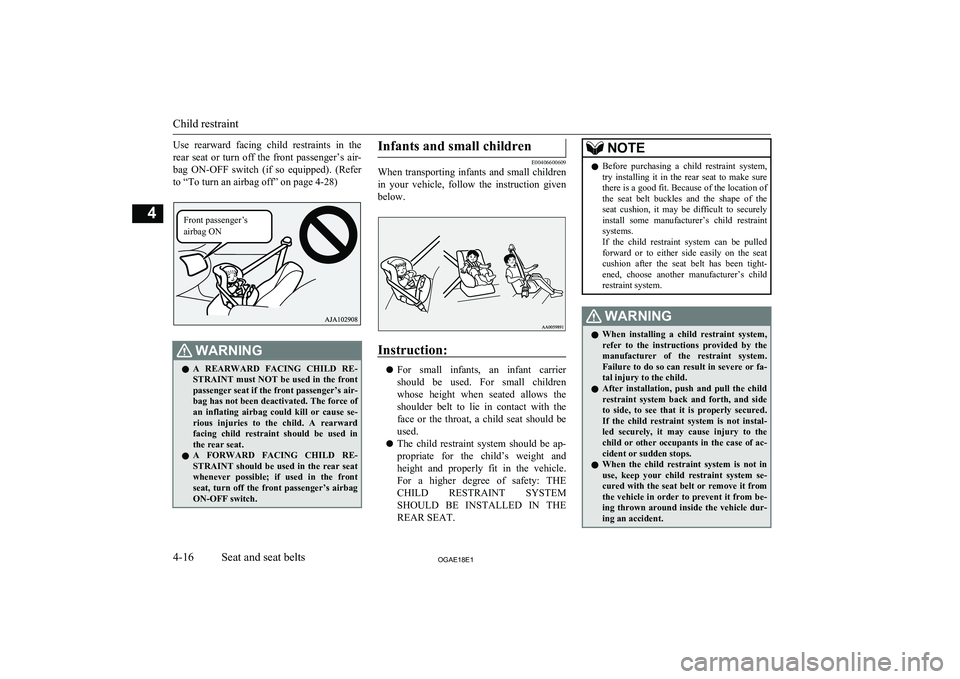
Use rearward facing child restraints in the
rear seat or turn off the front passenger’s air- bag ON-OFF switch (if so equipped). (Refer
to “To turn an airbag off” on page 4-28)WARNINGl A REARWARD FACING CHILD RE-
STRAINT must NOT be used in the front passenger seat if the front passenger’s air-
bag has not been deactivated. The force of an inflating airbag could kill or cause se-
rious injuries to the child. A rearward facing child restraint should be used in
the rear seat.
l A FORWARD FACING CHILD RE-
STRAINT should be used in the rear seat
whenever possible; if used in the front seat, turn off the front passenger’s airbag
ON-OFF switch.Infants and small children
E00406600609
When transporting infants and small children
in your vehicle, follow the instruction given below.
Instruction:
l For small infants, an infant carrier
should be used. For small children whose height when seated allows the shoulder belt to lie in contact with the
face or the throat, a child seat should be used.
l The child restraint system should be ap-
propriate for the child’s weight and
height and properly fit in the vehicle. For a higher degree of safety: THECHILD RESTRAINT SYSTEM
SHOULD BE INSTALLED IN THE REAR SEAT.
NOTEl Before purchasing a child restraint system,
try installing it in the rear seat to make surethere is a good fit. Because of the location of the seat belt buckles and the shape of theseat cushion, it may be difficult to securely
install some manufacturer’s child restraint
systems.
If the child restraint system can be pulled forward or to either side easily on the seatcushion after the seat belt has been tight-
ened, choose another manufacturer’s child restraint system.WARNINGl When installing a child restraint system,
refer to the instructions provided by themanufacturer of the restraint system.Failure to do so can result in severe or fa-tal injury to the child.
l After installation, push and pull the child
restraint system back and forth, and side to side, to see that it is properly secured.
If the child restraint system is not instal-
led securely, it may cause injury to the
child or other occupants in the case of ac- cident or sudden stops.
l When the child restraint system is not in
use, keep your child restraint system se-
cured with the seat belt or remove it from the vehicle in order to prevent it from be- ing thrown around inside the vehicle dur-
ing an accident.
Child restraint
4-16OGAE18E1Seat and seat belts4Front passenger’s
airbag ON
Page 88 of 514
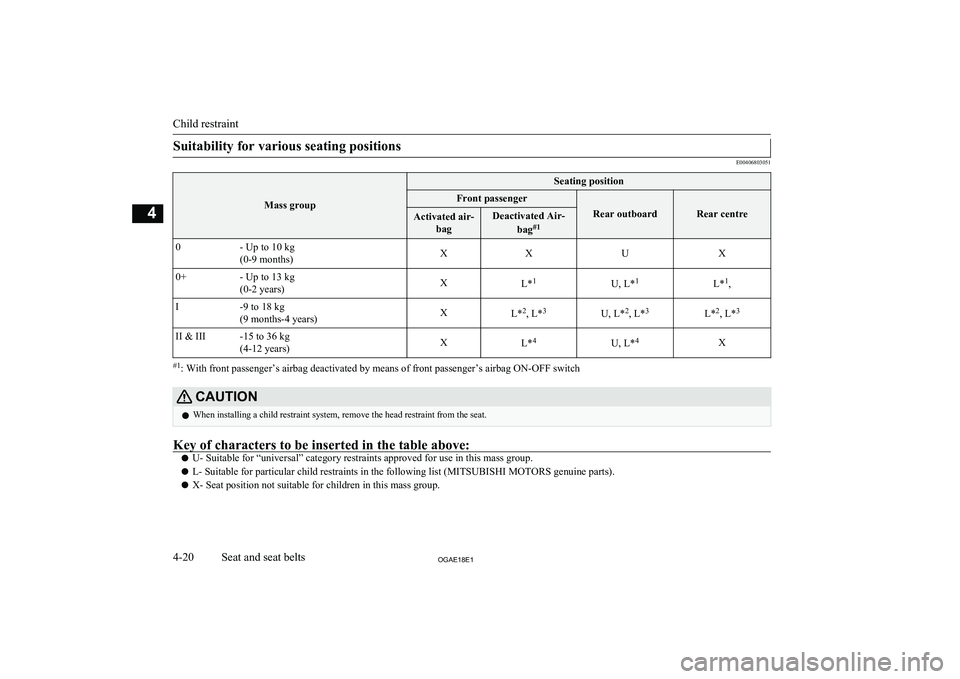
Suitability for various seating positions
E00406803051Mass group
Seating positionFront passenger
Rear outboardRear centre
Activated air-bagDeactivated Air-
bag#10- Up to 10 kg
(0-9 months)XXUX0+- Up to 13 kg
(0-2 years)XL* 1U, L* 1L*1
,I-9 to 18 kg
(9 months-4 years)XL* 2
, L* 3U, L* 2
, L* 3L*2
, L* 3II & III-15 to 36 kg
(4-12 years)XL* 4U, L* 4X
#1
: With front passenger’s airbag deactivated by means of front passenger’s airbag ON-OFF switch
CAUTIONl When installing a child restraint system, remove the head restraint from the seat.Key of characters to be inserted in the table above:
l
U- Suitable for “universal” category restraints approved for use in this mass group.
l L- Suitable for particular child restraints in the following list (MITSUBISHI MOTORS genuine parts).
l X- Seat position not suitable for children in this mass group.
Child restraint
4-20OGAE18E1Seat and seat belts4
Page 93 of 514
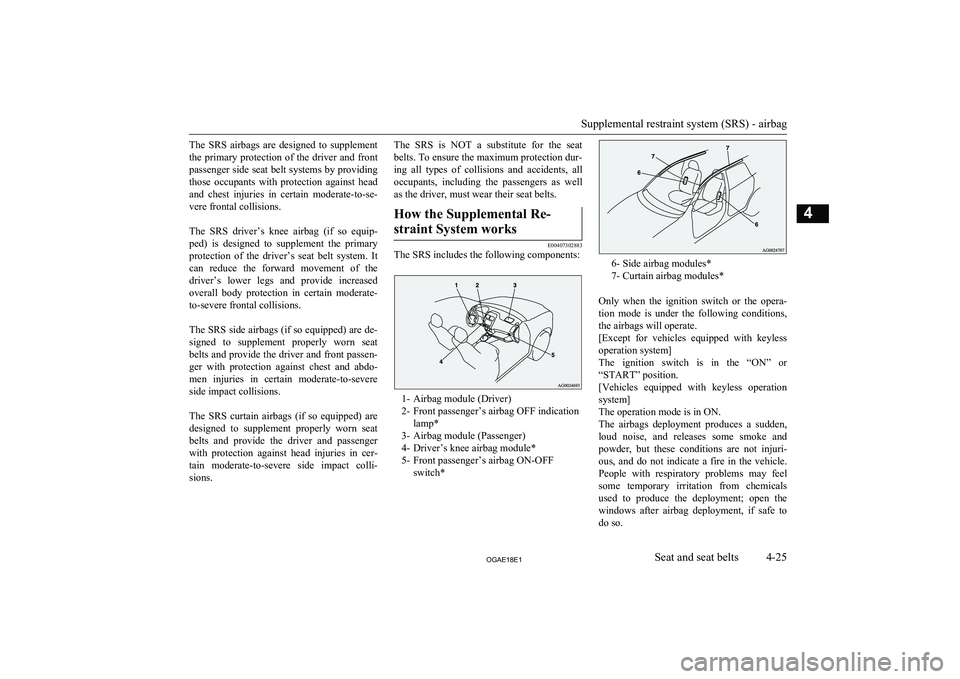
The SRS airbags are designed to supplementthe primary protection of the driver and front
passenger side seat belt systems by providing those occupants with protection against headand chest injuries in certain moderate-to-se- vere frontal collisions.
The SRS driver’s knee airbag (if so equip-
ped) is designed to supplement the primary
protection of the driver’s seat belt system. It can reduce the forward movement of the
driver’s lower legs and provide increased overall body protection in certain moderate-
to-severe frontal collisions.
The SRS side airbags (if so equipped) are de- signed to supplement properly worn seat belts and provide the driver and front passen-
ger with protection against chest and abdo-
men injuries in certain moderate-to-severe side impact collisions.
The SRS curtain airbags (if so equipped) are
designed to supplement properly worn seat belts and provide the driver and passenger with protection against head injuries in cer-
tain moderate-to-severe side impact colli- sions.
The SRS is NOT a substitute for the seat
belts. To ensure the maximum protection dur-
ing all types of collisions and accidents, all occupants, including the passengers as well
as the driver, must wear their seat belts.How the Supplemental Re-
straint System works
E00407302883
The SRS includes the following components:
1- Airbag module (Driver)
2- Front passenger’s airbag OFF indication lamp*
3- Airbag module (Passenger)
4- Driver’s knee airbag module*
5- Front passenger’s airbag ON-OFF switch*
6- Side airbag modules*
7- Curtain airbag modules*
Only when the ignition switch or the opera- tion mode is under the following conditions,
the airbags will operate.
[Except for vehicles equipped with keyless
operation system]
The ignition switch is in the “ON” or “START” position.
[Vehicles equipped with keyless operation
system]
The operation mode is in ON.
The airbags deployment produces a sudden,
loud noise, and releases some smoke andpowder, but these conditions are not injuri-
ous, and do not indicate a fire in the vehicle. People with respiratory problems may feel
some temporary irritation from chemicals
used to produce the deployment; open the
windows after airbag deployment, if safe to do so.
Supplemental restraint system (SRS) - airbag
4-25OGAE18E1Seat and seat belts4
Page 94 of 514

The airbags deflate very rapidly after deploy-
ment, so there is little danger of obscured vi- sion.CAUTIONl Airbags inflate at an extremely rapid speed.
In certain situations, contact with inflating airbags can result in abrasions, bruises, and the like.WARNINGl IT IS VERY IMPORTANT TO BE
PROPERLY SEATED.
A driver or front passenger too close to the steering wheel or instrument panel
during airbag deployment can be killed or seriously injured.
Airbags inflate very fast, and with great force.
If the driver and front passenger are not
properly seated and restrained, the air-
bags may not protect you properly, and could cause serious or fatal injuries whenit inflates.
l Do not sit on the edge of the seat or sit
with your lower legs too close to the in-
strument panel, or lean head or chest close to the steering wheel or instrument panel. Do not put feet or legs on or againstthe instrument panel.WARNINGl Place all infants and small children in the
rear seat and properly restrained using an
appropriate child restraint system.
The rear seat is the safest place for infants
and children.WARNINGl Infants and small children should never
be unrestrained, stand up against the in-strument panel or be held in your arms or on your lap. They could be seriously in-jured or killed in a collision, including when the airbag inflates. They should be
properly seated in the rear seat in an ap- propriate child restraint system. See the
“Child restraint” section of this owner’s
manual.
Use rearward facing child restraints in the
rear seat or turn off the front passenger’s air- bag ON-OFF switch (if so equipped). (Refer
to “To turn an airbag off” on page 4-28)
Supplemental restraint system (SRS) - airbag
4-26OGAE18E1Seat and seat belts4 Front passenger’s
airbag ON
Page 95 of 514
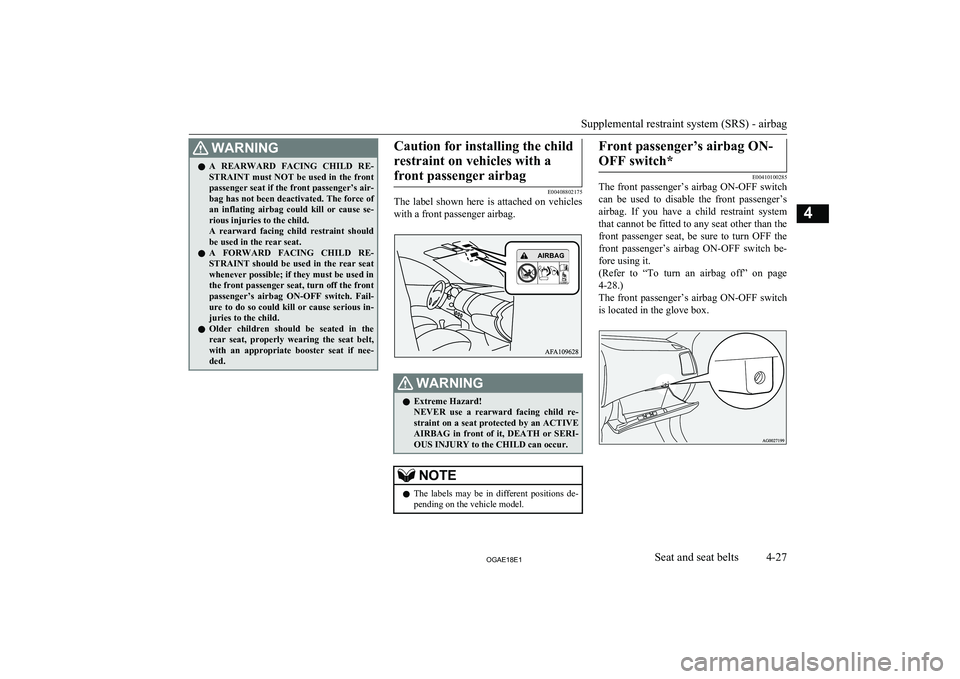
WARNINGlA REARWARD FACING CHILD RE-
STRAINT must NOT be used in the front passenger seat if the front passenger’s air-
bag has not been deactivated. The force of an inflating airbag could kill or cause se-
rious injuries to the child.
A rearward facing child restraint should be used in the rear seat.
l A FORWARD FACING CHILD RE-
STRAINT should be used in the rear seat
whenever possible; if they must be used in the front passenger seat, turn off the front
passenger’s airbag ON-OFF switch. Fail- ure to do so could kill or cause serious in-
juries to the child.
l Older children should be seated in the
rear seat, properly wearing the seat belt,with an appropriate booster seat if nee- ded.Caution for installing the child
restraint on vehicles with a front passenger airbag
E00408802175
The label shown here is attached on vehicles
with a front passenger airbag.
WARNINGl Extreme Hazard!
NEVER use a rearward facing child re- straint on a seat protected by an ACTIVEAIRBAG in front of it, DEATH or SERI- OUS INJURY to the CHILD can occur.NOTEl The labels may be in different positions de-
pending on the vehicle model.Front passenger’s airbag ON-
OFF switch*
E00410100285
The front passenger’s airbag ON-OFF switch
can be used to disable the front passenger’s airbag. If you have a child restraint system
that cannot be fitted to any seat other than the front passenger seat, be sure to turn OFF the front passenger’s airbag ON-OFF switch be-
fore using it.
(Refer to “To turn an airbag off” on page
4-28.)
The front passenger’s airbag ON-OFF switch
is located in the glove box.Supplemental restraint system (SRS) - airbag
4-27OGAE18E1Seat and seat belts4
Page 96 of 514
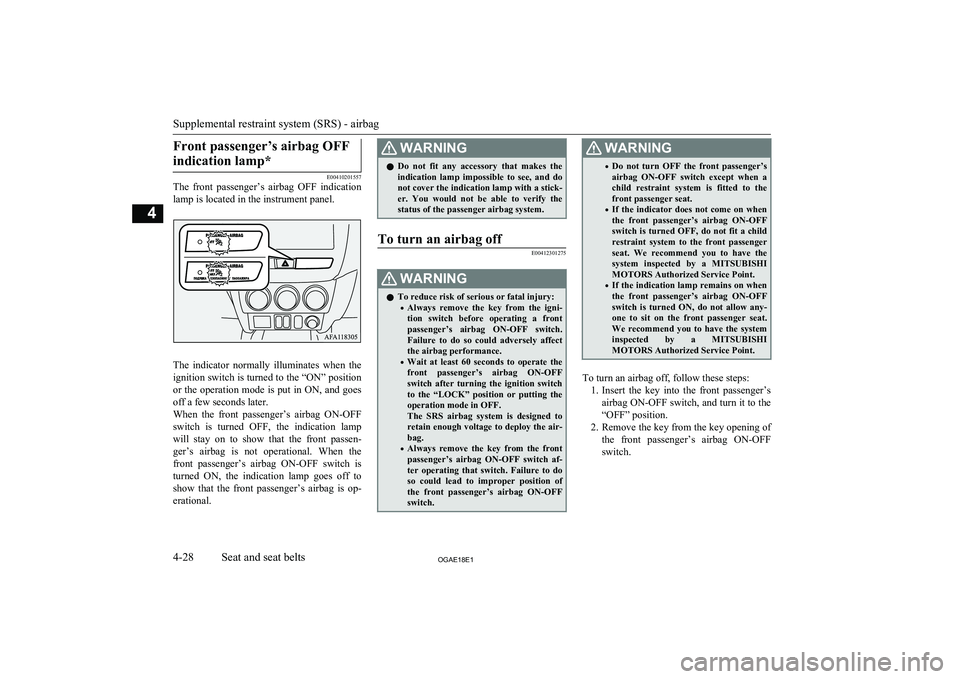
Front passenger’s airbag OFFindication lamp*
E00410201557
The front passenger’s airbag OFF indication
lamp is located in the instrument panel.
The indicator normally illuminates when the
ignition switch is turned to the “ON” position
or the operation mode is put in ON, and goes off a few seconds later.
When the front passenger’s airbag ON-OFF switch is turned OFF, the indication lamp will stay on to show that the front passen-
ger’s airbag is not operational. When the
front passenger’s airbag ON-OFF switch is
turned ON, the indication lamp goes off to show that the front passenger’s airbag is op-
erational.
WARNINGl Do not fit any accessory that makes the
indication lamp impossible to see, and do
not cover the indication lamp with a stick- er. You would not be able to verify thestatus of the passenger airbag system.To turn an airbag off
E00412301275WARNINGl To reduce risk of serious or fatal injury:
• Always remove the key from the igni-
tion switch before operating a front
passenger’s airbag ON-OFF switch. Failure to do so could adversely affect
the airbag performance.
• Wait at least 60 seconds to operate the
front passenger’s airbag ON-OFF switch after turning the ignition switch
to the “LOCK” position or putting the
operation mode in OFF.
The SRS airbag system is designed to retain enough voltage to deploy the air-
bag.
• Always remove the key from the front
passenger’s airbag ON-OFF switch af-ter operating that switch. Failure to do
so could lead to improper position of the front passenger’s airbag ON-OFF switch.WARNING• Do not turn OFF the front passenger’s
airbag ON-OFF switch except when a child restraint system is fitted to the
front passenger seat.
• If the indicator does not come on when
the front passenger’s airbag ON-OFF switch is turned OFF, do not fit a childrestraint system to the front passenger
seat. We recommend you to have the system inspected by a MITSUBISHI
MOTORS Authorized Service Point.
• If the indication lamp remains on when
the front passenger’s airbag ON-OFF switch is turned ON, do not allow any-
one to sit on the front passenger seat. We recommend you to have the systeminspected by a MITSUBISHI
MOTORS Authorized Service Point.
To turn an airbag off, follow these steps:
1. Insert the key into the front passenger’s
airbag ON-OFF switch, and turn it to the “OFF” position.
2. Remove the key from the key opening of
the front passenger’s airbag ON-OFF switch.
Supplemental restraint system (SRS) - airbag
4-28OGAE18E1Seat and seat belts4